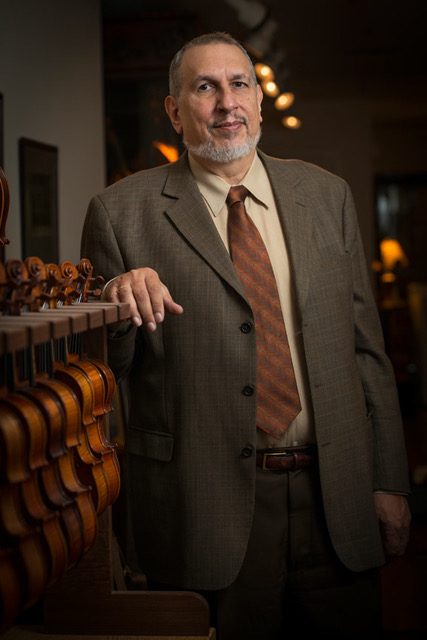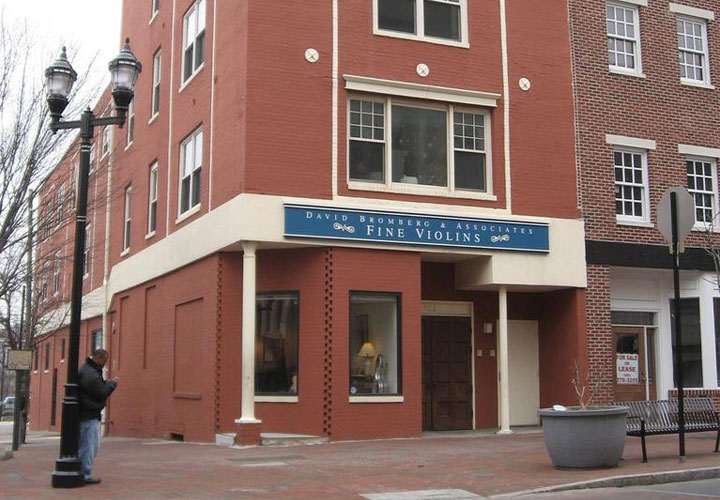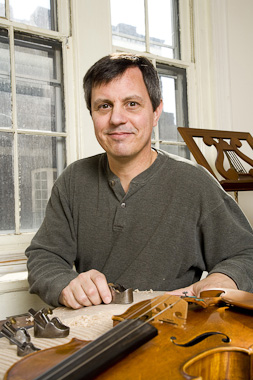The vintage guitar market focuses tightly on American names and American–made instruments. There are many highly regarded guitars from all over the world, but it's American builders like Fender, Gibson, and Martin that dominate the highest echelon of six–string commerce.
Historically, in the realm of fine violins, the opposite holds true. While contemporary American–made violins are experiencing something of a golden age, thanks to world class luthiers like Samuel Zygmuntowicz and Joseph Curtin, antique American violins have been broadly dismissed by players and collectors for generations.

David Bromberg with part of his collection of
American-made Violins.
"I do not think they have arrived where they should be, and I am skeptical that they ever will," American music chameleon and violin expert David Bromberg tells me on a recent phone conversation when asked about modern views of antique American instruments.
He would know.
Starting in the early '80s, Bromberg left a noted recording and touring career that included close collaborations with Bob Dylan and Jerry Jeff Walker to study the history and craft of the violin.
His resume as a performer and producer is staggering, but after years of steady touring, the multi–instrumentalist needed a break. He entered courses at the Kenneth Warren School of Violin Making (now the Chicago School of Violin Making) in 1980, and set about learning everything he could about the instrument.
Bromberg's fascination with American violins began a decade earlier when, while on the road, he purchased his first violin from a shop in Massachusetts. Bromberg was inspired to find an instrument similar to that of his bandmate Jay Unger, who PBS fans would know for his "Ashokan Farewell" — the theme from the Ken Burn's Civil War series.
"The fiddle that I picked out was American," Bromberg recalls. "I figured, this makes sense because I play American music. All kinds of American music."
That first fiddle launched Bromberg, who suffers from a self–diagnosed "collector's disease," on a journey of amassing the world's premiere American violin collection. That collection currently resides at David Bromberg Fine Violins in Wilmington, Delaware, a shop he opened with his wife Nancy Josephson in 2002.
Bromberg has worked tirelessly to revitalize the global reputation of antique American instruments in violin circles, and his collection stands as a living testament to their legacy.
As Bromberg explains, "At that time, which would have been the early '70s, the violin makers in the United States felt that all the violin makers who came before them had been terrible… Every now and then, there would be a good [violin], but if it was American, they decided that it was not worth fixing up. So I managed to buy a few and that was the beginning of my collection."
At that time, the violin makers in the United States felt that all the violin makers who came before them had been terrible… Every now and then, there would be a good [violin], but if it was American, they decided that it was not worth fixing up."
Several decades and approximately 263 historic violins later, Bromberg's collection has grown so revered and is so representative of American violin history that he is negotiating a possible acquisition by the Library of Congress.
Carol Lynn Ward–Bamford is the curator of musical instruments at the Library and explains that the acquisition is a work in progress.
"We have an agreement with David to hopefully try to acquire it, I would say, in the next year or so," explains Ward–Bamford.
She speaks to me from some level of sub–basement in DC, surrounded by artifacts and instruments representing America's musical heritage. "We are in the process of renovating our musical instruments vault, and the collection could very well fit in there. The vault is humidity and temperature controlled, but we can make it very accessible."
That last note on accessibility underlines the core institutional goal of the library. In contrast to museums where instruments are kept under close guard in locked glass cases, the Library's mission centers on both preserving its instruments and making them accessible to the public.
In fact, the musical instrument collection at the Library of Congress grew from a gift from Gertrude Clarke Whittall, who donated five Stradivari in 1935. Per the terms of her bequeathment, these instruments are still regularly played as part of the Library's programming.

David Bromberg Fine Violins in Wilmington, Delaware
"I think the same thing with David’s collection," explains Ward–Bamford. "We would want to find the funds for maintenance and programming, so that they can be a legacy and stay that way."
In speaking with both Bromberg and Ward–Bamford, it's clear that the exact process for the collection's transfer has stalled for now, yet everyone seems optimistic that it will happen eventually.
"They are trying to raise the money that would be able to buy about a third of my collection," explains Bromberg. "I will donate the other two–thirds but, as of yet, they have not really started the campaign."
Regardless of its location — in Washington or Wilmington — there is no arguing that the Bromberg collection stands as the key archive of an American instrument–building legacy that stretches back centuries.
A Quick History of American Violin Craft
Christopher Germain is a violin maker and author who operates a shop in Philadelphia. He co–wrote a book titled The American Violin that was published last year and represents the most comprehensive survey of American violin and bow makers to date. Like Bromberg — his classmate in violin school — he is a professional that lives and breathes violins.
"I divide my time between making new instruments, violins, violas, cellos, some instrument restoration, and repairs," explains Germain. "I deal in stringed instruments and bows as well and have a shop in Philadelphia in Center City."

Christopher Germain
From Germain's perspective, American violin history breaks into three broad periods.
The first comes from the Colonial period, when naïve settlers would construct crude instruments as they could. "Some of the earliest makers were not really specifically trained in the craft," Germain explains. "They may have had a different profession and play the violin as a hobby and decide, 'Well, I am going to make a violin because it is pretty hard to find violins around here.'"
This class of crude, amatuer–built instruments helped foment the historical reputation of American–made violins as inferior to their European contemporaries.
The second period comes in the 19th century, as European–trained luthiers immigrated to America and hung their shingles in its many growing cities.
"In the 19th century, the quality of the work was greatly improved because of the growth of major cities in America and the establishment of large shops," Germain explains.
"Since there were no professionally trained luthiers in the US, many of those people came and immigrated from Europe… They were professionally trained in their various European countries, whether it was France, Germany, or Italy."
Both Bromberg and Germain point to George Gemunder as a key representation of this period. According to Bromberg, George was one of "three brothers from the Gemunder family in Germany who came over, and was the first really fine American violin maker."
In Germain's timeline, the third epoch of American violin craft began in the mid–20th century and continues through the present day. This new period marks a highpoint of the craft and a genuine renaissance of masterfully built classical string instruments in America and abroad.
In the past 30 years, there has been an entire generation of American–born and trained makers who have brought their craft to a very high standard and are producing instruments which are of extremely high quality."
Germain considers himself part of this movement, and points to other makers like Samuel Zygmuntowicz and MacArthur fellow Joseph Curtin as key figures on the modern scene.
"In the past 30 years, there has been an entire generation of American–born and trained makers who have brought their craft to a very high standard and are producing instruments which are of extremely high quality — the types of instruments that musicians find very worthy to play on," says Germain.
Like the modern boutique guitar market, US luthiers do not even try to compete with Asian manufacturers in lower price brackets. Instead, today's American violin makers operate in small workshops, making individual instruments much the way the old masters of Europe did historically.
The global musical instrument market saw antique violin prices skyrocket in the '70s and '80s as Western classical music has become more popular in China, Japan, and elsewhere. In turn, these newly crafted American instruments have become a viable alternative for many professional musicians due to high quality and modest costs compared to those fine 18th–century European instruments.
"You have heard the name Stradivari," Germain explains. "He is considered the greatest violin maker of all time. If a musician wants to acquire a Stradivari, they would be prepared to pay anywhere from say, five to 15 million dollars, and what musician can afford that?"
Changing Attitudes
While many are looking to this new crop of American violins as some of the finest in the world, there still are — as in the guitar market — plenty of buyers and aficionados who continue to equate old with good.
Though Stradivari, Amati, and other violins built in Cremona, Italy in the 17th and 18th centuries are still widely considered the finest of all time, their mythical supremacy is being questioned more and more.
Consider a series of double–blind tests conducted by acoustic researcher Claudia Fritz of the Pierre and Marie Curie University in Paris. In her studies, first–rate antique Italian violins — including multiple Strads — were pitted against modern instruments.
These studies have revealed very low correlation between a violin's age or maker and the general preferences of the test subjects. In fact, throughout these studies, contemporary violins scored the highest marks with players and audience members alike.
The Paris Double-Blind Violin Experiment (2012)
Despite these shifting tides, the reputation of American violins still has a ways to go. "The United States is near the bottom of the list in the rank, but we are climbing fast," explains Bromberg. "As far as contemporary makers go, some of the best in the world, without doubt or question, are in the United States."
Concurrent with this renaissance in violin lutherie, dismissive attitudes toward antique American instruments are beginning to thaw. Both Germain and Ward–Bamford agree that Bromberg's work has made the difference.
"David, as a musician, was really the earliest person to appreciate and collect American violins," says Germain. "He sought the merit and had an interest from a very early time, and that's why he was able to amass such a fine collection."
As to the curatorial impact of said collection, Ward–Bamford recognizes that "David worked hard to try to show the violins. [They] have been on exhibit in different places, and I think people are really more aware now of the great artistry of American work."
While he believes that there still is much work to be done, Bromberg himself acknowledges that his efforts over the years have had an impact.
"The [perception] has changed hugely, and I am told I am mostly responsible for that. I've given at least three lectures to the Violin Society of America, I spoke to the Federation of American Violin and Bow Makers, and to the International Entente of Violin Makers.
"I have done a lot of campaigning and people started to open their eyes… The figment has changed quite a bit. It is very hard for me to add to my collection now; it's too expensive."
—
Special thanks to David Bromberg for speaking with us about his collection. David's latest album, The Blues, The Whole Blues and Nothing but the Blues is available now. David and his band will be on tour in the US throughout the summer and fall. Thanks also to Christopher Germain — for more info on Christopher's book, see the American Violin website.
